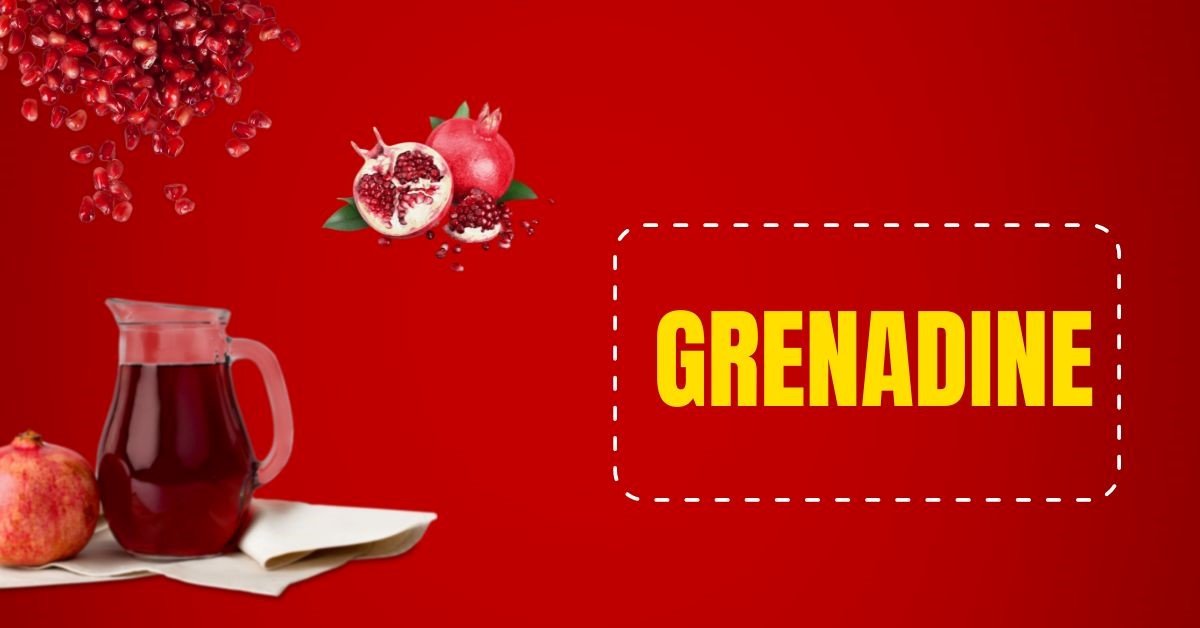FOOD
Grenadine: The Sweet History Behind the Iconic Red Syrup

Grenadine—just the name evokes a sense of sweetness, color, and nostalgia. This deep red syrup has been a staple in bars and kitchens for over a century, lending its distinctive hue and flavor to countless cocktails and mocktails. From Shirley Temples to Tequila Sunrises, grenadine adds not only taste but also beauty to every drink it touches. But beyond its vibrant color lies a fascinating story of evolution, culture, and craftsmanship. Let’s take a detailed look into the world of grenadine—its history, composition, uses, and why it continues to reign supreme in mixology.
The Origin of Grenadine
The word “grenadine” comes from the French word grenade, meaning “pomegranate.” Historically, true grenadine was made from pomegranate juice, sugar, and water. It originated in France and the Mediterranean region, where pomegranates were abundant and prized for their rich flavor and color. The syrup was initially created as a sweetener and coloring agent for both alcoholic and non-alcoholic beverages, long before it became a cocktail essential.
Over time, grenadine spread to other parts of Europe and the Americas, where it gained popularity for its ability to transform simple drinks into visually stunning creations. Its tart-sweet profile perfectly balanced strong liquors, making it a must-have in the growing world of cocktails during the early 20th century.
Read More: The Truth About White Food Dye: Uses, Safety, and Facts
Traditional Composition of Grenadine
Authentic grenadine was traditionally made by reducing pomegranate juice with sugar to form a thick, ruby-red syrup. The balance of sweetness and acidity gave it a distinctive flavor—bright, fruity, and slightly tangy. In some recipes, small amounts of orange blossom water or lemon juice were added to enhance the aroma and complexity.
Unfortunately, as commercial production increased, many brands replaced natural ingredients with artificial flavors, corn syrup, and red dye. While these imitations mimic the color, they lack the depth and authenticity of real pomegranate-based grenadine. In recent years, however, there’s been a resurgence of craft grenadines made with natural ingredients, as bartenders and enthusiasts seek to revive the syrup’s original glory.
The History of Grenadine in Cocktails
Grenadine’s rise in cocktail culture can be traced back to the late 19th and early 20th centuries, during the golden age of mixology. Its versatility and visual appeal made it a favorite among bartenders who wanted to create drinks that were as beautiful as they were delicious.
One of the earliest documented uses of grenadine in cocktails dates to the 1890s, appearing in drinks like the Ward 8, Jack Rose, and Clover Club. These classic recipes showcased grenadine’s ability to add both color and balance—its sweetness softening the bite of strong spirits while enhancing fruit-based notes.
The Role of Grenadine in Non-Alcoholic Drinks
Beyond cocktails, grenadine found fame in the world of mocktails and soft beverages. Perhaps the most famous is the Shirley Temple, a beloved childhood drink made with ginger ale or lemon-lime soda, grenadine, and a maraschino cherry on top. The Roy Rogers, a similar drink made with cola, also became a staple at diners and restaurants.
Grenadine’s bright, sweet flavor makes it a natural addition to juices, sodas, and even teas. It adds a hint of sophistication and fun to beverages without the need for alcohol, making it a favorite among all age groups.
Cultural Significance of Grenadine
Grenadine’s appeal extends beyond its flavor—it carries cultural symbolism as well. Its striking red color is often associated with passion, love, and celebration. Throughout history, pomegranates themselves have symbolized fertility, abundance, and eternal life in various cultures, from ancient Greece to the Middle East.
When grenadine became a fixture in Western bars, it carried a bit of that symbolism with it. Its inclusion in festive and romantic drinks turned it into a visual shorthand for joy and togetherness. Even today, a splash of grenadine can transform a plain drink into something worth celebrating.
The Science Behind the Color and Flavor
The signature red hue of authentic grenadine comes from anthocyanins, natural pigments found in pomegranates. These compounds are not only beautiful but also rich in antioxidants, giving grenadine a potential health benefit when made naturally. The tartness of pomegranate juice comes from citric and malic acids, which give the syrup its tangy kick and help balance sweetness.
Artificial versions, on the other hand, rely on food coloring (usually Red No. 40) and flavor additives, which create the same look but a flatter taste. That’s why many bartenders prefer homemade or artisanal grenadine—it offers a brighter, more nuanced flavor that enhances rather than overpowers a drink.
Homemade Grenadine: A Return to Authenticity
Making grenadine at home is surprisingly simple and far more rewarding than buying artificial versions. To prepare authentic grenadine, all you need is fresh pomegranate juice, sugar, and a touch of lemon juice. The mixture is simmered until slightly thickened, resulting in a vibrant, tangy syrup.
Homemade grenadine not only tastes better but also allows you to control the level of sweetness and acidity. Some modern recipes even add orange blossom water, rose water, or a hint of molasses for extra depth. Once you’ve made your own, you’ll never want to go back to store-bought.
Popular Cocktails Featuring Grenadine
Grenadine is a star player in many iconic cocktails. Among the most famous are:
- Tequila Sunrise: Made with tequila, orange juice, and grenadine, this drink creates a stunning layered effect reminiscent of a sunrise.
- Shirley Temple: A kid-friendly favorite combining grenadine with soda and a cherry garnish.
- Clover Club: A pre-Prohibition classic made with gin, lemon juice, egg white, and grenadine.
- Jack Rose: Featuring applejack, lemon juice, and grenadine, this cocktail has a tart yet smooth profile.
- Singapore Sling: A complex tropical cocktail that includes gin, cherry brandy, and grenadine for color and sweetness.
Each of these drinks highlights grenadine’s versatility—it can adapt to various spirits and flavor profiles while always adding visual flair.
Grenadine in Modern Mixology
In the modern cocktail scene, grenadine is experiencing a renaissance. Mixologists are rediscovering its original pomegranate roots and using it in creative ways. Beyond its traditional role in cocktails, grenadine is now used in culinary applications like desserts, marinades, and salad dressings.
Craft bars and restaurants often make their own grenadine in-house, sometimes experimenting with ingredients like hibiscus, raspberry, or cranberry to create new variations. These artisanal approaches have helped reestablish grenadine’s reputation as a sophisticated, high-quality ingredient rather than a sugary afterthought.
Health Aspects of Grenadine
While commercial grenadine is mostly sugar and artificial coloring, authentic pomegranate-based grenadine has some nutritional value. Pomegranates are rich in antioxidants, vitamin C, and anti-inflammatory compounds. Homemade versions made with natural juice retain some of these benefits, though it’s still a syrup and should be enjoyed in moderation.
For health-conscious drinkers, using less sugar or substituting with natural sweeteners like honey or agave can make grenadine a slightly healthier choice without sacrificing flavor.
Grenadine Substitutes
If you run out of grenadine, several substitutes can work depending on the recipe. Pomegranate molasses, raspberry syrup, or even cherry juice can replicate its fruity sweetness and red hue. However, none quite match the balance of tart and sweet that true grenadine provides. That unique harmony is what makes it irreplaceable in classic cocktails.
The Future of Grenadine
As the cocktail industry moves toward authenticity and quality, grenadine’s future looks bright. Bartenders and home enthusiasts alike are seeking out natural ingredients and traditional methods, breathing new life into this centuries-old syrup. With more brands returning to real pomegranate-based recipes, grenadine is reclaiming its rightful place as a symbol of craftsmanship and creativity.
Conclusion
Grenadine is far more than just a red syrup—it’s a piece of culinary and cultural history. From its Mediterranean origins to its modern-day mixology revival, grenadine has proven its timeless appeal. Its balance of sweetness, tartness, and beauty has made it an essential ingredient for over a century. Whether drizzled into a cocktail, stirred into a mocktail, or crafted at home from fresh pomegranates, grenadine reminds us that the simplest ingredients often create the most lasting impressions.
Read More: The SEO Secrets Behind Local Food Bloggers’ Success: Lessons for All
FAQs
1. What is grenadine made of?
Authentic grenadine is made from pomegranate juice, sugar, and water, while commercial versions often use artificial flavors and dyes.
2. Is grenadine alcoholic?
No, grenadine is a non-alcoholic syrup used to flavor and color drinks.
3. Can you make grenadine at home?
Yes, homemade grenadine is easy to make with fresh pomegranate juice and sugar, offering a more natural and flavorful result.
4. What drinks use grenadine?
Popular drinks include the Tequila Sunrise, Shirley Temple, Jack Rose, and Clover Club.
5. Why is grenadine red?
Its natural red color comes from pomegranate pigments called anthocyanins, though artificial versions use food coloring.
-

 Tech1 year ago
Tech1 year agoHow to Use a Temporary Number for WhatsApp
-

 Business2 years ago
Business2 years agoSepatuindonesia.com | Best Online Store in Indonesia
-

 Social Media1 year ago
Social Media1 year agoThe Best Methods to Download TikTok Videos Using SnapTik
-

 Technology1 year ago
Technology1 year agoTop High Paying Affiliate Programs
-

 Tech10 months ago
Tech10 months agoUnderstanding thejavasea.me Leaks Aio-TLP: A Comprehensive Guide
-

 FOOD12 months ago
FOOD12 months agoHow to Identify Pure Desi Ghee? Ultimate Guidelines for Purchasing Authentic Ghee Online
-

 Instagram3 years ago
Instagram3 years agoFree Instagram Auto Follower Without Login
-

 Instagram3 years ago
Instagram3 years agoFree Instagram Follower Without Login




















